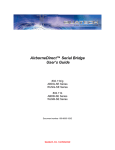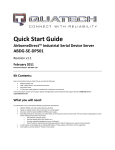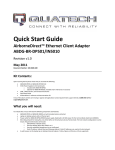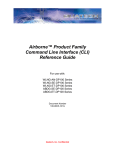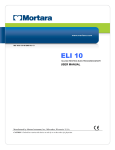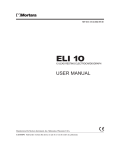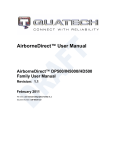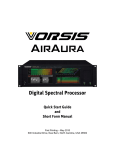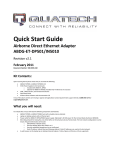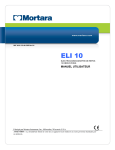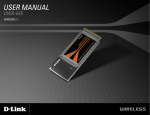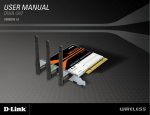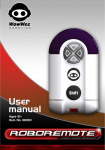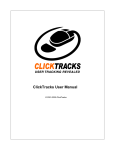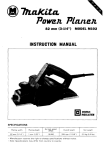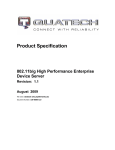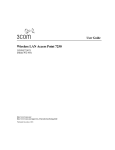Download Quatech ABDB-ET Series Network Router User Manual
Transcript
AirborneDirect™ Ethernet Bridge User’s Guide PP T 802.11b/g ABDG-ET Series WLNG-ET Series T 802.11b ABDB-ET Series WLNB-ET Series Document number 100-8007-141G Quatech, Inc. Confidential ALL RIGHTS RESERVED. No part of this publication may be copied in any form, by photocopy, microfilm, retrieval system, or by any other means now known or hereafter invented without the prior written permission of Quatech, Inc. This document may not be used as the basis for manufacture or sale of any items without the prior written consent of Quatech, Inc. AirborneDirect™ is a trademark of Quatech, Inc. All other trademarks used in this document are the property of their respective owners. Copyright © 2005-2007 Quatech, Inc Disclaimer The information in the document is believed to be correct at the time of print. The reader remains responsible for the system design and for ensuring that the overall system satisfies its design objectives taking due account of the information presented herein, the specifications of other associated equipment and the test environment. Quatech, Inc has made commercially reasonable efforts to ensure that the information contained in this document is accurate and reliable. However, the information is subject to change without notice. No responsibility is assumed by Quatech, Inc for the use of the information, nor for infringements of patents or other rights of third parties. This document is the property of Quatech, Inc. and does not imply license under patents, copyrights or trade secrets. Quatech, Inc. Headquarters QUATECH Inc.. 5675 Hudson Industrial Parkway Hudson, OH 44236 USA Telephone: Toll Free: Fax: Email: Web Site: 330-655-9000 800-553-1170 330-655-9010 [email protected] [email protected] www.quatech.com CONTENTS CHAPTER 1 INTRODUCTION................................................................................................................................1 TFEATURES AND BENEFITST ............................................................................................................................ 2 SAMPLE APPLICATION .................................................................................................................................. 3 TUSING THIS DOCUMENTT ............................................................................................................................... 4 CONVENTIONS ............................................................................................................................................. 5 TTerminology .......................................................................................................................................... 5 TNotes ..................................................................................................................................................... 5 TCautions ................................................................................................................................................ 5 RELATED DOCUMENTATION .......................................................................................................................... 6 CHAPTER 2 HARDWARE INSTALLATION ........................................................................................................7 TSTANDARD PACKAGE CONTENTS .................................................................................................................. 7 STANDARD PACKAGE HARDWARE DESCRIPTION ............................................................................................ 9 Reset Switch ......................................................................................................................................... 9 Indicator LEDs..................................................................................................................................... 10 Mounting Cradle.................................................................................................................................. 12 HEAVY-DUTY PACKAGE ............................................................................................................................. 13 Indicator LEDs..................................................................................................................................... 15 SELECTING A LOCATION ............................................................................................................................. 16 CONNECTING THE BRIDGE.......................................................................................................................... 17 CHAPTER 3 INITIAL CONFIGURATION............................................................................................................19 WIRELESS CONFIGURATION ........................................................................................................................ 19 VERIFYING YOUR CONNECTIONS ................................................................................................................ 21 WPA-LEAP SECURITY .............................................................................................................................. 22 System Requirements......................................................................................................................... 22 Computer Resource Requirements .................................................................................................... 22 System Implementation Considerations ............................................................................................. 22 CHAPTER 4 AIRBORNE CONTROL CENTER.................................................................................................25 LAUNCHING THE ACC ................................................................................................................................ 25 NAVIGATING AROUND THE ACC ................................................................................................................... 27 PERFORMING CONFIGURATION ACTIVITIES .................................................................................................. 27 SAVING CONFIGURATION CHANGES ............................................................................................................ 29 BASIC CONFIGURATION SETTINGS .............................................................................................................. 30 Status Page (Basic Configuration Settings)........................................................................................ 30 Miscellaneous Settings Page (Basic Configuration Settings)............................................................. 31 ADVANCED CONFIGURATION SETTINGS....................................................................................................... 41 Services Page (Advanced Configuration Settings)............................................................................. 41 Security Settings Page (Advanced Configuration Setting) ................................................................. 43 Update Firmware Page (Advanced Configuration Settings)............................................................... 45 Reset Page (Advanced Configuration Settings) ................................................................................. 48 CHAPTER 5 TROUBLESHOOTING....................................................................................................................50 TROUBLESHOOTING SUGGESTIONS ............................................................................................................ 50 LED TROUBLESHOOTING ........................................................................................................................... 52 APPENDIX A SPECIFICATIONS ..........................................................................................................................53 APPENDIX B FCC COMPLIANCE........................................................................................................................59 FCC STATEMENT .................................................................................................................................. 59 FCC RF EXPOSURE STATEMENT........................................................................................................ 59 INFORMATION FOR CANADIAN USERS (IC NOTICE) ...................................................................................... 59 MANUFACTURER’S DECLARATION OF CONFORMITY ..................................................................................... 60 100-8007-141G AirborneDirect™ Ethernet Bridge User's Guide Quatech, Inc. Confidential Page i Contents INDUSTRY CANADA NOTICE (APPLICABLE TO USE WITHIN CANADA) ............................................................. 60 AVIS DE CONFORMITE A LA REGLEMENTATION D’INDUSTRIE CANADA ............................................................ 61 INDUSTRY CANADA (IC) EMISSIONS COMPLIANCE STATEMENT..................................................................... 61 AVIS DE CONFORMITE A LA REGLEMENTATION D’INDUSTRIE CANADA ............................................................ 61 EUROPEAN COMMUNITY—CE NOTICE ........................................................................................................ 61 ...................................................................................................................................................... 61 ............................................................................................................................................................. 62 GLOSSARY...............................................................................................................................................................65 INDEX.........................................................................................................................................................................69 Page ii AirborneDirect™ Ethernet Bridge User's Guide Quatech, Inc. Confidential 100-8007-141G Contents LIST OF FIGURES Figure 1. Basic Application Involving a LAN Host and Ethernet Client ........................................3 Figure 2. AirborneDirect™ Ethernet Bridge Hardware (standard package).................................9 Figure 3. Indicator LEDs on the AirborneDirect™ Ethernet Bridge............................................10 Figure 4. Mounting Cradle Dimensions......................................................................................12 Figure 5. AirborneDirect™ Ethernet Bridge Hardware (heavy-duty package) ............................13 Figure 6. AirborneDirect™ Heavy-Duty Cable (Evaluation Kit Item)...........................................14 Figure 7. End Cap Pin-out and Connector Location ...................................................................15 Figure 8. Device detection .........................................................................................................25 Figure 9. Device login ................................................................................................................26 Figure 10. Status Page ..............................................................................................................26 Figure 11. ACC Navigation Bar..................................................................................................27 Figure 12. Saved Settings Screen .............................................................................................29 Figure 13. Reset Notice Screen.................................................................................................29 Figure 14. Status Page ..............................................................................................................30 Figure 15. Miscellaneous OEM Settings Page ..........................................................................31 Figure 16. Wireless Network Configuration Page ......................................................................33 Figure 17. Network Services Page ............................................................................................41 Figure 18. Security Configuration Page .....................................................................................43 Figure 19. Update Firmware Page.............................................................................................45 Figure 20. Precautionary Message ............................................................................................46 Figure 21. Update Complete Message ......................................................................................47 Figure 22. Reset Page ...............................................................................................................48 Figure 23. Confirm Restart..........................................................................................................49 Figure 24. Reset In Progress .....................................................................................................49 100-8007-141G AirborneDirect™ Ethernet Bridge User's Guide Quatech, Inc. Confidential Page iii Contents LIST OF TABLES Table 1. AirborneDirect™ Ethernet Bridge Features and Benefits ..............................................2 Table 2. AirborneDirect™ Ethernet Bridge Indicator LEDs.......................................................11 Table 3. AirborneDirect™ Heavy-Duty Ethernet Bridge Indicator LEDs .....................................15 Table 4. Recording Information from Your Access Point’s Configuration Application ................20 Table 5. Miscellaneous OEM Settings .......................................................................................32 Table 6. Wireless Network Configuration Settings.....................................................................35 Table 7. Region Country Codes.................................................................................................40 Table 8. Network Services Settings ...........................................................................................42 Table 9. Security Configuration Settings....................................................................................44 Table 10. Troubleshooting Suggestions ....................................................................................50 Table 11. Indicator LED Troubleshooting ..................................................................................52 Table 12. Specifications.............................................................................................................53 Table 13. Heavy-Duty Power Supply Specifications ...................................................................58 Table 14. Heavy-Duty DC Specifications ....................................................................................58 Page iv AirborneDirect™ Ethernet Bridge User's Guide Quatech, Inc. Confidential 100-8007-141G CHAPTER 1 INTRODUCTION This guide describes the AirborneDirect™ Ethernet Bridge from Quatech, Inc. AirborneDirect™ is a fully integrated, 802.11 wireless Local Area Network (LAN) connectivity device designed to provide wireless LAN and Internet connectivity in industrial, scientific, medical, and transportation applications where an existing communications interface already exists. The AirborneDirect™ Ethernet Bridge is well suited to the following applications: T Point-of-sale devices. T Medical equipment. T Manufacturing machinery. T Bar-code readers. T Time clocks. T Scales. T Data-collection devices. T Vehicle Diagnostics. T Telematics. T The AirborneDirect™ Ethernet Bridge provides true plug-and-play wireless connectivity. By delivering convenient, easy-to-deploy wireless network connectivity, the Bridge significantly reduces the complexities of wireless system deployment and network implementation. At the same time, users can move equipment without the cost and time associated with wired network drops and environment restrictions. This provides flexibility for seasonal demands, line and staffing changes, and more. T The AirborneDirect™ Ethernet Bridge provides a bridge between the 802.11 wireless LAN and any Ethernet-ready device with an RJ-45 connector. It acts transparently between the device and a wireless LAN. By integrating AirborneDirect™ into existing and legacy platforms, OEMs can significantly enhance their products by delivering increased value and functionality to their entire customer base. T The AirborneDirect™ Ethernet Bridge opens the world of remote device monitoring and management (as well as wide-area data collection) to any device, machine, or plant that has an Ethernet connection and a network infrastructure. The development kit provides quick and easy access to the Bridge’s configuration and functions, while providing OEMs with a platform to develop their branded solutions. The Bridge also provides the capability to perform firmware upgrades that allow new features to be added quickly and easily, protecting your investment. T 100-8007-141G AirborneDirect™ Ethernet Bridge User's Guide Quatech, Inc. Confidential Page 1 Introduction FEATURES AND BENEFITS T T The key features and benefits of the AirborneDirect™ Ethernet Bridge are described in Table 1. T TX XT T Table 1. AirborneDirect™ Ethernet Bridge Features and Benefits Feature Small package outline T Benefit Easy to attach to existing equipment; light enough to allow easy mounting to vertical surfaces. T T T External antenna connection T Improved control over deployment by using a standard antenna connector that provides multiple antenna configurations, including omni-directional wand, patch, and panel solutions. T T Allows the Bridge to be placed close to the Ethernet link and power supply, while the antenna can be located remotely from the Bridge for optimum placement and reception. T T Integrated Ethernet cable and connector T Simplifies use by requiring no extra cables or connectors. T T T Ideal OEM solution T A complete package for OEMs to easily and quickly integrate the AirborneDirect™ Ethernet Bridge into their product range. T T T Fully integrated 802.11 WLAN module includes radio, baseband, and application processor Full 802.11 compatibility T No RF design or network software development needed (accelerates time-to-market while reducing development costs and risks). T T T T Eliminates cables: provides Intranet or Internet connectivity using industry-standard wireless infrastructure. T T T Built-in TCP/IP stack, RTOS and application software T Provides embedded products with LAN and Internet connectivity. Does not require special programming, only simple configuration. T T Designed specifically for industrial, scientific, medical, and automotive applications T T Industrial specifications ensure robust and reliable performance in demanding system environments. T T T Connectivity options include TCP/IP, ARP, ICMP, DHCP, DNS, Telnet, and UDAP T Rel iable data transport for Ethernet devices. T T T Page 2 AirborneDirect™ Ethernet Bridge User's Guide Quatech, Inc. Confidential 100-8007-141G Introduction SAMPLE APPLICATION Figure 1 shows a basic application where the AirborneDirect™ Ethernet Bridge is exchanging data wirelessly between an Ethernet client and a LAN host. In this application: X X T The Ethernet client can be any device with an Ethernet port that is directly connected to the AirborneDirect™ Ethernet Bridge. T T T T The LAN host can be a network-based PC or server that requires connection to the Ethernet Client using the network. The LAN host communicates with the AirborneDirect™ Ethernet Bridge over a wireless network connection via an attached Access Point (AP). T T Figure 1. Basic Application Involving a LAN Host and Ethernet Client 100-8007-141G AirborneDirect™ Ethernet Bridge User's Guide Quatech, Inc. Confidential Page 3 Introduction USING THIS DOCUMENT T T In addition to this chapter, this guide contains the following chapters and appendixes: Chapter 2, Hardware Installation ⎯ describes the AirborneDirect™ Ethernet Bridge hardware and how to install it. Chapter 3, Initial Configuration ⎯ describes how to configure the AirborneDirect™ Ethernet Bridge on your network Chapter 4, Using the Airborne Control Center (ACC) ⎯ describes how to use the Windows-based application to configure, manage, and view the status of the AirborneDirect™ Ethernet Bridge. Chapter 5, Troubleshooting ⎯ provides troubleshooting suggestions in the unlikely event you encounter a problem using the AirborneDirect™ Ethernet Bridge. Appendix A, Specifications ⎯ lists the AirborneDirect™ Ethernet Bridge specifications. Appendix B, FCC Compliance ⎯ contains FCC compliance information. Appendix C, Glossary ⎯ defines the terms associated with the AirborneDirect™ Ethernet Bridge and wireless networks in general. T For convenience, an Index appears at the end of this guide. Page 4 AirborneDirect™ Ethernet Bridge User's Guide Quatech, Inc. Confidential 100-8007-141G Introduction CONVENTIONS The following conventions are used in this guide: Terminology T In the following chapters, these terms are used: “AirborneDirect™ Ethernet Bridge” is used the first time the Bridge is mentioned in a chapter. Thereafter, the term “Bridge” is used. “Ethernet client” refers to the device to which the AirborneDirect™ Ethernet Bridge is connected and which communicates with the Bridge over an RJ-45 connection. “LAN host” refers to a LAN-based computer running a HyperTerminal or Telnet session, Web Browser, or LAN-based application that communicates with the Bridge via a wireless network connection. Notes T A note is information that requires special attention. The following convention is used for notes. T A note contains information that deserves special attention. Note: T T T T Cautions T A caution contains information that, if not followed, can cause damage to the product or injury to the user. The following convention is used for cautions. T A caution contains information that, if not followed, can cause damage to Caution: the product or injury to the user. T T T T 100-8007-141G AirborneDirect™ Ethernet Bridge User's Guide Quatech, Inc. Confidential Page 5 Introduction RELATED DOCUMENTATION In addition to this guide, the following documents are provided on the CD supplied with the AirborneDirect™ Ethernet Bridge: AirborneDirect™ Ethernet Bridge User’s Guide. T AirborneDirect™ Ethernet Bridge Quick Start Guide. T Product Briefs and Application Notes. T These documents are provided as Portable Document Format (PDF) files. To read them, you need Adobe® Acrobat® Reader® 4.0.5 or higher. For your convenience, Adobe Reader is provided on the Evaluation Kit CD. For the latest version of Adobe Acrobat Reader, go to the Adobe Web site (www.adobe.com). P P P P P P Additional literature about AirborneDirect™ products and the Airborne WLN Module that powers them, such as application notes, product briefs, and white papers, can be found on the Quatech Web site: www.quatech.com. T HTU UTH Quatech also offers developer documentation for its AirborneDirect™ products. Please contact Quatech for more information. T Page 6 AirborneDirect™ Ethernet Bridge User's Guide Quatech, Inc. Confidential 100-8007-141G CHAPTER 2 HARDWARE INSTALLATION This chapter describes the AirborneDirect™ Ethernet Bridge. Topics in this chapter include: T T Package Contents. (below) T Items Supplied by the User. (below) T Hardware Description. (page 9) T X X Selecting a Location. (page 13) T X X Configuring The Access Point. (page 16) T X X Connecting the Bridge. (page 17) T T X X Verifying Your Connections. (page 21) T X STANDARD PACKAGE CONTENTS T Before beginning the hardware installation, verify that the hardware package contains: T One AirborneDirect™ Ethernet Bridge with an attached cable and an RJ-45 interface connector. One AC power adapter and cord. One AirborneDirect™ mounting cradle (mounting hardware is user-supplied). If you have the AirborneDirect™ Evaluation Kit, you should also have received: One Access Point (AP), IEEE 802.11b/g-compliant with DHCP enabled (optional). An AirborneDirect™ Ethernet Quick Start Guide. A CD containing this AirborneDirect™ Ethernet Bridge User’s Guide, the AirborneDirect™ Ethernet Bridge Evaluation Kit Quick Start Guide, product briefs and application notes, Adobe® Reader® for viewing the documents and an Airborne™ Control Center (ACC). If any item is missing, damaged, or improperly functioning, contact Quatech. 100-8007-141G AirborneDirect™ Ethernet Bridge User's Guide Quatech, Inc. Confidential Page 7 Hardware Installation ITEMS SUPPLIED BY THE USER T The following items, which are not included in the package contents, are also required: T An Ethernet client, with an RJ-45 jack, that is within the transmit and receive range of the Access Point to be used with the Bridge. T A LAN host running any operating system with TCP/IP (the ACC requires Microsoft® Windows® XP or Windows 2000). T P P P P An IEEE 802.11b/g-compliant Access Point with DHCP enabled. T T Mounting hardware for the AirborneDirect™ bracket mounting. Note: T T Other Access Points in the area may interfere with the Bridge’s ability to associate with your chosen Access Point (the Bridge will try to associate with the first available “best-quality” AP). If you encounter difficulties with connecting to your chosen AP, either remove power from these Access Points or move to an isolated location, and then perform the setup in Figure 1 on page 3. X Page 8 AirborneDirect™ Ethernet Bridge User's Guide Quatech, Inc. Confidential 100-8007-141G Hardware Installation STANDARD PACKAGE HARDWARE DESCRIPTION X Figure 2 identifies the components on the Bridge in its standard packaging. These components include: X X An external antenna. An RJ-45 jack and cable attached to the Bridge. A Reset switch on the bottom of the Bridge. Three indicator Light Emitting Diodes (LEDs) on the top of the Bridge. A mounting cradle. Figure 2. AirborneDirect™ Ethernet Bridge Hardware (standard package) Reset Switch The bottom of the AirborneDirect™ Bridge provides access to a Reset Switch. The Reset switch returns all Bridge parameters to their factory default firmware settings. To reset Bridge parameters, press (and hold) this switch for at least 5 seconds after power is applied to the Bridge. To protect against accidental resets, the Reset switch is recessed. 100-8007-141G AirborneDirect™ Ethernet Bridge User's Guide Quatech, Inc. Confidential Page 9 Hardware Installation Indicator LEDs The Bridge has three indicator LEDs for viewing its current status and its connections (see Figure 3). These indicators allow for monitoring and troubleshooting of the Bridge. They also indicate the Bridge’s power-up status, link, connection, and data-activity status. Table 2 describes the status of the indicator LEDs. X X X X Figure 3. Indicator LEDs on the AirborneDirect™ Ethernet Bridge Page 10 AirborneDirect™ Ethernet Bridge User's Guide Quatech, Inc. Confidential 100-8007-141G Hardware Installation Table 2. AirborneDirect™ Ethernet Bridge Indicator LEDs LED Power Link Comm LED Color Off Function Bridge is not receiving power. Red Bridge failed its Power On Self Test (POST) and is not configured for wireless communication. Amber Bridge passed its POST but is not configured for wireless communication. Green Bridge passed its POST and is configured for wireless communication. Off Bridge is not receiving power. Blinking Red Bridge is searching for an Access Point. Green Wireless network and MAC have associated with an Access Point. Off No power, or no wireless TCP session is established and no Ethernet physical connection is detected. Red No wireless TCP session is established; an Ethernet physical connection is detected. Blinking Red An Ethernet physical connection was detected and there is Ethernet traffic present on that connection, but no wireless TCP session is established. Amber A wireless TCP connection is established but no physical Ethernet connection is detected (i.e., no Ethernet cable is attached to the Bridge). Blinking Green A wireless TCP session is established, a physical Ethernet connection is detected, and the Bridge is transmitting or receiving data across the wired Ethernet port. Green A wireless TCP session is established, a physical Ethernet connection is detected, but there is no active data movement across the wired Ethernet port. 100-8007-141G AirborneDirect™ Ethernet Bridge User's Guide Quatech, Inc. Confidential Page 11 Hardware Installation Mounting Cradle The Bridge comes with a mounting cradle that allows the Bridge to be installed on a vertical surface, such as a wall (see Figure 4). Be careful not to tighten the mounting hardware (usersupplied) excessively to avoid damaging the cradle. When mounting the Bridge vertically, attach the cradle to the vertical surface, and then insert the Bridge into the cradle. X X Figure 4. Mounting Cradle Dimensions Page 12 AirborneDirect™ Ethernet Bridge User's Guide Quatech, Inc. Confidential 100-8007-141G Hardware Installation HEAVY-DUTY PACKAGE The heavy-duty version of the Bridge is supplied in a Deutsch EEC-325X4B enclosure and is available in both sealed and unsealed versions. The heavy-duty Bridge supports SAE J1455 power specifications (+4.5 to 36 VDC). Figure 5 identifies the components on the Bridge in its heavy-duty packaging. These components include: An external antenna. A Deutsch 12-pin DTM13-12PA-R008 receptacle for power and signal connections. A Reset switch. Four indicator Light Emitting Diodes (LEDs) on the top of the Bridge. Figure 5. AirborneDirect™ Ethernet Bridge Hardware (heavy-duty package) Figure 6 shows the universal adapter cable supplied with AirborneDirect™ Heavy-Duty Evaluation Kits. 100-8007-141G AirborneDirect™ Ethernet Bridge User's Guide Quatech, Inc. Confidential Page 13 Hardware Installation Figure 6. AirborneDirect™ Heavy-Duty Cable (Evaluation Kit Item) Page 14 AirborneDirect™ Ethernet Bridge User's Guide Quatech, Inc. Confidential 100-8007-141G Hardware Installation Indicator LEDs The Heavy-Duty Bridge has four indicator LEDs for viewing its current status and connections (see Figure 5). These indicators allow for monitoring and troubleshooting of the Bridge. They also indicate the Bridge’s power-up status, link, connection, and data-activity status. Table 3 describes the status of the indicator LEDs. Table 3. AirborneDirect™ Heavy-Duty Ethernet Bridge Indicator LEDs CONN LINK CFG POST Name Description POST Power on self test completed CFG Device has a valid IP address LINK Device has successfully associated/authenticated with an AP. CONN TCP/IP connection established with device. End Cap Layout The connectors required to attach to the device are: Ethernet/Power: RF: Deutsch DTM-06-12SSA RP-SMA (Male) Note: FACTORY RESET hole is optional, if a sealed enclosure is required. Figure 7. End Cap Pin-out and Connector Location 100-8007-141G AirborneDirect™ Ethernet Bridge User's Guide Quatech, Inc. Confidential Page 15 Hardware Installation SELECTING A LOCATION You can mount the Bridge on a flat surface, such as a desk or table, or on a vertical surface, such as a wall. It can also be mounted on the ceiling. If you mount the Bridge vertically, use the supplied mounting cradle previously described. Choosing a good location for the Bridge is important because it affects the reliability of the wireless link. The most important considerations are distance from the Access Point and clearance from obstacles. When considering a location for installing the Bridge, ensure that it: Provides sufficient ventilation around the Bridge. Allows easy access to disconnect the Bridge from the AC wall outlet if necessary. Does not expose the Bridge to excessive heat, humidity, vibration, or dust. Conforms to local regulations. Because radio waves travel in a straight line, the location where you will install the Bridge must provide a clear path to the Access Point that is free of major obstacles. The effects of obstacles, both along and near the path, have a significant bearing on the travel of radio signals and can cause both interference and signal cancellation. Consider the effects of the following common obstacles: Trees and large plants A tree or large plant directly in the path can totally block the signal. With clearance above the trees, there are usually no blocking effects. Man-made obstacles Square or rectangular objects, in or near the path, have rectangular surfaces that can block and interfere with signals over and around them. Floor A floor can interfere with signals if the Bridge is mounted too low. Mount the Bridge so the antenna is high enough to allow adequate clearance from the floor. Page 16 AirborneDirect™ Ethernet Bridge User's Guide Quatech, Inc. Confidential 100-8007-141G Hardware Installation CONNECTING THE BRIDGE The following procedure describes how to connect the Bridge: • Place the Bridge in a dry, clean location near the device to which it will be connected. The location is required to have an AC power source and be within 300 feet (100 meters) of an IEEE 802.11b/g-compliant wireless LAN Access Point with DHCP enabled. The location should be away from transformers, heavy-duty motors, fluorescent lights, microwave ovens, refrigerators or other equipment that could cause radio-signal interference. Note: Do not connect the Bridge to the intended Ethernet client at this time. • Raise the antenna on the Bridge so it is pointing vertically. • Connect the supplied power adapter to the Bridge and to a grounded 110/240V, 50-60Hz AC power source. • If your Access Point is using WEP or WPA, disable the security. You can re-enable WEP or WPA after the Bridge has been configured. • Connect the RJ-45 jack on the Bridge’s Ethernet cable to an RJ-45 jack on your Ethernetready device. 100-8007-141G AirborneDirect™ Ethernet Bridge User's Guide Quatech, Inc. Confidential Page 17 Hardware Installation This page intentionally left blank. Page 18 AirborneDirect™ Ethernet Bridge User's Guide Quatech, Inc. Confidential 100-8007-141G CHAPTER 3 INITIAL CONFIGURATION This chapter describes configuring the AirborneDirect™ Ethernet Bridge. Topics in this chapter include: Wireless Configuration. (below) Verifying Your Connections (page 20) WPA-LEAP Security. (page 20) WIRELESS CONFIGURATION After you verify that the indicator LEDs have gone through their power-up sequence, start the configuration application for your Access Point (your Access Point manual should describe this procedure). Then go the appropriate screen in the application and perform the following steps: Access Point configuration applications vary between models and Note: manufacturers. In the following steps, there are suggested screen names where you might find the Access Point settings required to operate the Bridge. The screens in your Access Point’s configuration application may differ from those mentioned below. Refer to the documentation that came with your Access Point to locate the appropriate screens where these settings can be accessed. • Find the Service Set Identifier String (SSID) Go to the Wireless Settings or equivalent screen in your Access Point’s configuration application that shows the Access Point’s SSID. Record the SSID in Table 4 (on page 20). You will need this information to configure the Bridge. • Disable Wireless Security Go to the Wireless Settings, Security, Encryption, or equivalent screen in your Access Point’s configuration application that shows the WEP/WPA setting. If WEP or WPA is enabled, disable it (you can enable the AP security after the Bridge has been configured). • Find the Bridge’s Internet Protocol (IP) Address Go to the Attached Devices or equivalent screen in your Access Point’s configuration application that lists the IP addresses of devices attached to the Access Point. Find the IP address for the Bridge and record it in Table 4 (on page 20). You will need it to access the Bridge with the Airborne Control Center (ACC). 100-8007-141G AirborneDirect™ Ethernet Bridge User's Guide Quatech, Inc. Confidential Page 19 Initial Configuration If you do not see the Bridge as an attached device, refresh the configuration Note: screen (some Access Point programs provide a Refresh button for this purpose). If the Bridge still does not appear, refer to the troubleshooting chapter in this Guide and in the documentation for your Access Point. Note: You can also use the device discovery feature of the Airborne Control Center software (see page 25) to help determine the Bridge’s IP address. X • Verify the MAC Address Go to the Attached Devices or equivalent screen in your Access Point’s configuration application that lists the MAC addresses of attached devices. Verify that the MAC address shown for the Bridge matches the one on the label on the back of the Bridge. • Verify the Dynamic Host Configuration Protocol (DHCP) Name Go to the Router Status or equivalent screen in your Access Point’s configuration application that shows the Bridge’s DHCP client name. Verify that this name matches the last six characters in the Bridge’s MAC address (AIRBORNExxxxxx) on the label on the back of the Bridge. Table 4. Recording Information from Your Access Point’s Configuration Application Parameter Value Access Point’s SSID Bridge’s IP address Note: If the Bridge is unable to obtain an IP address through DHCP, after the acquire limit is exceeded (150 seconds) the bridge will install the fallback IP address (192.168.10.1) and subnet (255.255.255.0). The bridge can be accessed using this address, after DHCP fails, by the attached host using a different IP address in the same subnet (192.168.10.8). Page 20 AirborneDirect™ Ethernet Bridge User's Guide Quatech, Inc. Confidential 100-8007-141G Initial Configuration VERIFYING YOUR CONNECTIONS When the Bridge is powered-up, the indicator LEDs at the top of the Bridge will indicate the status of the Bridge. See Table 2 on page 11 for standard packaging, or Table 3 on page 15 for Heavy-Duty packaging. If the LEDs indicate a problem with a wired or wireless connection, remove the power source from the Bridge, wait a few seconds, and re-apply power. If the LEDs still do not behave appropriately, see the guidelines in Table 11 on page 52. Other Access Points in the area may interfere with the Bridge’s ability to Note: associate with your chosen Access Point (the Bridge will try to associate with the first available “best-quality” AP). If you encounter difficulties with connecting to your chosen AP, either remove power from these Access Points or move to an isolated location and perform the setup shown in Figure 1 on page 3. 100-8007-141G AirborneDirect™ Ethernet Bridge User's Guide Quatech, Inc. Confidential Page 21 Initial Configuration WPA-LEAP SECURITY The WPA and LEAP software modules provide advanced security configuration and communication services required by today’s enterprise-class deployments. Please refer to IEEE standard 802.1x 2001 (section 4) and IEEE standard 802.11i 2004 (section 4) for additional information. System Requirements Both WPA and LEAP require radio firmware version 1.1.1.111.8.4 or later. The AP requires WPA support. LEAP must be supported in the AP or a separate authentication server. Computer Resource Requirements WPA-PSK In order to function properly, an Access Point that supports WPA-PSK must be available. The WPA-PSK passphrase installed on the Access Point must match the passphrase configured on the bridge. LEAP In order to function properly, a RADIUS server configured for LEAP containing usernames/passwords, and an Access Point that supports LEAP, must be available. The RADIUS server username and password must match the user-leap and pw-leap command values configured on the bridge. The blank character (space) may not be included in a passphrase or LEAP Note: password. System Implementation Considerations The bridge must be in infrastructure mode for WPA-PSK or LEAP to operate properly. A bridge configured for WPA-PSK requires a connection to an AP with WPA-PSK enabled. A bridge configured for LEAP requires a connection to an AP with LEAP enabled and connected to a RADIUS server to provide authentication. Until the bridge is authenticated by either the WPA-PSK enabled AP or the RADIUS server, no IP network communication can proceed. Symptoms of an unauthenticated client include: A bridge configured for DHCP will not obtain host configuration from the DHCP server; therefore, the IP address will remain 0.0.0.0. Page 22 AirborneDirect™ Ethernet Bridge User's Guide Quatech, Inc. Confidential 100-8007-141G Initial Configuration The Link LED turns green when 802.11 association completes. However, if the 802.1x authentication fails, the bridge becomes disassociated by the AP and the Link LED goes back to flashing red. The bridge will not respond to discovery requests. Once the bridge is authenticated, additional impacts include: Roaming A bridge configured for WPA-PSK can only roam to APs that have WPA-PSK enabled in the same ESS. A bridge configured for LEAP can only roam to APs that support LEAP, roaming, and are connected to the same RADIUS server. Data Throughput and Latency Round trip latency may increase and overall throughput may decrease, due to the additional steps to encrypt or decrypt data. Re-Keying The session key may expire and the authentication process will be executed again causing streaming data to stop until a new key is authorized. 100-8007-141G AirborneDirect™ Ethernet Bridge User's Guide Quatech, Inc. Confidential Page 23 Initial Configuration This page intentionally left blank. Page 24 AirborneDirect™ Ethernet Bridge User's Guide Quatech, Inc. Confidential 100-8007-141G CHAPTER 4 AIRBORNE CONTROL CENTER This chapter describes how to use the Airborne Control Center (ACC) to configure the AirborneDirect™ Ethernet Bridge. The ACC is a user-friendly graphical-user interface (GUI) menu and data display. The interface is intuitive, allowing tasks to be performed simply by pointing and clicking your mouse. LAUNCHING THE ACC On the Windows XP Start menu, navigate to the Quatech submenu and click on Airborne Control Center. The ACC scans the local subnet for Airborne devices and displays a list like the one shown in Figure 5. X X Figure 8. Device detection Highlight the desired device and click the Select button. The ACC displays the login page for the selected device as shown in Figure 6. X X Note: The MAC address for the device you wish to connect to can be found on the label located on the back of the enclosure. Note: The 802.11b Bridge (ABDB or WLNB models) has a web interface available if the firmware does not contain the optional LEAP feature. The web interface is virtually identical to the ACC interface, so all of the information in this chapter applies to the web interface also. To access the web interface, enter the IP address of the Bridge in the address bar of the browser. The web interface requires Microsoft Internet Explorer 5 or later. Note: The 802.11b/g Bridge (ABDG or WLNG models) have no web interface. 100-8007-141G AirborneDirect™ Ethernet Bridge User's Guide Quatech, Inc. Confidential Page 25 Airborne Control Center Figure 9. Device login The IP address and telnet port number of the selected device are automatically transferred to the login page. Enter the user name and password (defaults “dpac” and “dpac”) and click on the OK button to login. To select a different device, click the Discover button to reinitiate the device detection scan. The Status page is displayed as shown in Figure 7. X X Figure 10. Status Page Page 26 AirborneDirect™ Ethernet Bridge User's Guide Quatech, Inc. Confidential 100-8007-141G Airborne Control Center NAVIGATING AROUND THE ACC A navigation bar appears at the top-right side of every screen in the ACC interface (see Figure 8). This bar contains links that correspond to the pages you can access. To go to a page, click the appropriate link in the navigation bar. X X Figure 11. ACC Navigation Bar PERFORMING CONFIGURATION ACTIVITIES The ACC allows you to perform a variety of configuration activities. Basic configuration activities consist of the following steps. See “Network Settings Page” on page 33. X X X X Configuring the Bridge for Infrastructure mode Infrastructure mode prepares the Bridge for use with an Access Point. Assigning a Service Set Identifier (SSID) to the Bridge To allow a connection between the Bridge and an Access Point, the SSID of the two devices must be identical. If the Bridge is configured with an SSID of “any”, it will connect to the Access Note: Point with the best signal, so long as all security settings match. Enabling Wireless Security (optional) Wired Equivalent Privacy (WEP) and WiFi Protected Access (WPA) are security protocols for wireless local area networks (WLANs), defined in the 802.11 standard. Choosing Static or DHCP Assignment of IP Address If DHCP is used, a client name can be assigned to allow identification of specific bridges on a network. Assigning user discovery name The user discovery name identifies the Bridge in Evaluation and Management Utilities (if Enable UDAP is checked in the Services Page). 100-8007-141G AirborneDirect™ Ethernet Bridge User's Guide Quatech, Inc. Confidential Page 27 Airborne Control Center Advanced configuration activities consist of the following: Changing the user name and administrator password Lets you change the user name and administrator password for accessing the configuration interface. See “Security Settings Page” on page 43. X X X X X X X Resetting the Bridge Lets you reset the Bridge to the factory-default settings. See “Reset Page” on page 48. X X Updating Bridge Firmware Updating Bridge firmware allows you to take advantage of new features as they become available. See “Update Firmware Page” on page 45. X X Restarting the Bridge Lets you restart (reboot) the Bridge. See “Reset Page” on page 48. X X X X X Modifying Device Services Settings Lets you change port numbers and timeouts for the TCP and telnet ports. See “Services Page” on page 41. X X Page 28 X X AirborneDirect™ Ethernet Bridge User's Guide Quatech, Inc. Confidential 100-8007-141G Airborne Control Center SAVING CONFIGURATION CHANGES Some pages have Save and Cancel buttons. If you change parameters on one of these pages, click Save to apply your changes or Cancel to discard them. Once the changes are saved, the ACC displays the screen shown in Figure 9. To continue, click Yes, or you can go to another page to make more changes then click Restart to apply all the changes at one time. X X The ACC will display Figure 10. Wait for the Restart to complete. Once the Restart has completed, the ACC will redisplay the Status Page. X X If the Status Page does not reappear, determine whether the Bridge’s IP Note: address changed. If it did, click the Login button on the ACC navigation bar and let the ACC discover the Bridge. Otherwise, try the Bridge’s old IP address again. The ACC may timeout before the Bridge can obtain its DHCP lease. Figure 12. Saved Settings Screen Figure 13. Reset Notice Screen 100-8007-141G AirborneDirect™ Ethernet Bridge User's Guide Quatech, Inc. Confidential Page 29 Airborne Control Center BASIC CONFIGURATION SETTINGS Status Page (Basic Configuration Settings) Figure 14. Status Page The Status Page is the first page that appears in the ACC. This read-only page shows information about the Bridge. You may need to click the Status button in the navigation bar to update the contents on this page. This page shows the Bridge’s version number, 802.11 status, network settings, and resources. Parameters to note on this screen are: MAC address is the MAC address of the Bridge. BSSID is the MAC address of the associated Access Point (AP). RSSI indicates the receive signal strength in dBm. Page 30 AirborneDirect™ Ethernet Bridge User's Guide Quatech, Inc. Confidential 100-8007-141G Airborne Control Center Miscellaneous Settings Page (Basic Configuration Settings) Figure 15. Miscellaneous OEM Settings Page Clicking the Misc link in the navigation bar displays the Miscellaneous OEM Settings page. In this page, you can enter the Bridge’s OEM version string and discovery name. This page also lets you specify the OEM user name and password. 100-8007-141G AirborneDirect™ Ethernet Bridge User's Guide Quatech, Inc. Confidential Page 31 Airborne Control Center Table 5. Miscellaneous OEM Settings Parameter Description Miscellaneous OEM Settings OEM Version String Specifies the OEM version string to be associated with the Bridge. Default is oemverstr. OEM Discovery Name Specifies the OEM discovery name to be associated with the Bridge. Default is OEM-Cfg1. OEM Authentication Settings OEM User Name Specifies the name of the OEM, from 1 to 31 alphanumeric characters. Name is case-sensitive. Default is oem. OEM Password Two fields where you type and retype the OEM password, from 1 to 31 alphanumeric characters. Password is case-sensitive. For security, each password character appears as an asterisk. Default is oem. Page 32 AirborneDirect™ Ethernet Bridge User's Guide Quatech, Inc. Confidential 100-8007-141G Airborne Control Center Network Settings Page (Basic Configuration Settings) The Network Settings Page allows you to modify the 802.11 wireless network settings, including network identification, security, data rate, and discovery name. You are also able to set Network IP settings for control of the wired LAN, including enabling DHCP, static IP address and associated network settings. This page actually displays more than one page of information. Use the Note: scroll bar to scroll down to see all of the items on the page. Figure 16. Wireless Network Configuration Page 100-8007-141G AirborneDirect™ Ethernet Bridge User's Guide Quatech, Inc. Confidential Page 33 Airborne Control Center Figure 13. Wireless Network Configuration Page (continued) X X Figure 13. Wireless Network Configuration Page (continued) X Page 34 X AirborneDirect™ Ethernet Bridge User's Guide Quatech, Inc. Confidential 100-8007-141G Airborne Control Center Table 6. Wireless Network Configuration Settings Parameter Description Wireless Network Settings SSID Service Set Identifier that identifies the common service set for the Bridge and AP. To make this connection, the Bridge and AP must have the same SSID. Default setting is any (this field may not be blank). Wireless Network Type Specifies the type of network in which the Bridge will be used: • Infrastructure – connects to a WLAN using an AP. (default) • Ad-Hoc – used to connect two peer-topeer devices. Ad-Hoc Mode Channel When Wireless Network Type is Ad-Hoc, selects the channel used for communication. The two peer-to-peer devices must use the same channel. Range is 1 to 14 channels. Default channel is 1. WLAN Region Code Bridge Operation Region Specifies the wireless channels allowed. See Table 6. Region Country Codes on page 40. X X X X Default is US. 100-8007-141G AirborneDirect™ Ethernet Bridge User's Guide Quatech, Inc. Confidential Page 35 Airborne Control Center Wireless Security Settings Enables or disables wireless security: Wireless Security Mode • Disable – Disable any security (default) • WEP64 – 64-bit key length (11 ASCII characters) • WEP128 – 128-bit key length (26 ASCII characters) • WPA-PSK - WPA with preshared key. Requires preshared key • WPA-LEAP - WPA with 802.1x (LEAP) • WPA-LEAP64 • WPA-LEAP128 - WPA with 802.1x (LEAP) authentication, and using "WPA Migration Mode" (static 128-bit WEP key is used for broadcast and multicast traffic) • WPA-PSK64 - WPA with preshared key, and using "WPA Migration Mode" (static 64-bit WEP key is used for broadcast and multicast traffic) Requires preshared key. • WPA-PSK128 - WPA with preshared key, and using "WPA Migration Mode" (static 128-bit WEP key is used for broadcast and multicast traffic) Requires preshared key. authentication. Requires LEAP username and password - WPA with 802.1x (LEAP) authentication, and using "WPA Migration Mode" (static 64-bit WEP key is used for broadcast and multicast traffic) WPA Passphrase (Preshared Key) Configures the Pre-Shared Key used with WPA-PSK security. LEAP Username Configures the WPA-LEAP username. The input range is 8 to 63 ASCII characters or 64 hex characters. This key must match the key on the AP. The LEAP username [1 to 32 characters] must match the LEAP username assigned on the LEAP server. The LEAP username cannot contain spaces. Page 36 AirborneDirect™ Ethernet Bridge User's Guide Quatech, Inc. Confidential 100-8007-141G Airborne Control Center LEAP Password Configures the WPA-LEAP password. The LEAP password [1 to 32 characters] must match the LEAP password assigned to the LEAP user on the LEAP server. The LEAP password cannot contain spaces. Defines the type of key authentication, if any, to be used: Authentication • Automatic • Open System – communicates the key across the network • Shared Key – automatically detects the authentication (default) – allows communication only with devices with identical WEP settings Default Key Default WEP Key from 1 – 4 if Shared Key or Both is selected for Authentication. Default is WEP Key 1. WEP Key 1 through 4 Up to four WEP key values. These values must be the same as the key implemented by the Access Point. Enable WPA Information Element format compatibility mode • If WEP Encryption = 64, enter 10 hexadecimal digits for each key. • If WEP Encryption = 128, enter 26 hexadecimal digits for each key. Controls the format of the WPA Information Element used in the Association Request management frame. Several brands of Access Points still use the legacy WPA format. When unchecked, enables the Legacy WPA Information Element format. When checked, enables the 802.1x WPA Information Element format. Default is unchecked. Parameter Description Advanced Settings Module MAC Address Bridge’s MAC address. Default is factory set. Do not change this value; otherwise, unexpected results can occur. Antenna Mode • Ant2 • Diversity – allows the Bridge to select the antenna receiving the best quality signal. 100-8007-141G – use primary antenna (J2) (default) AirborneDirect™ Ethernet Bridge User's Guide Quatech, Inc. Confidential Page 37 Airborne Control Center Maximum Transmission Rate Bridge’s maximum wireless transmission rate. The Bridge will attempt the highest specified rate and fallback to a lower rate if necessary. Default is 5.5 Mbps. Network IP Settings Enable DHCP Client When checked, enables the Dynamic Host Configuration Protocol (DHCP). For this parameter to work, the AP or network must support DHCP. DHCP Client Name Bridge’s DHCP client name. Enable DHCP Fixed Interval Retransmission Enables the interval value below. DHCP Retransmit Interval Configures the DHCP request retransmission interval (in seconds) to use when the DHCP retransmission is set to fixed. This is an integer with a range of 1-64. Default is 15. Configures the number of seconds that the Module should wait to acquire its IP configuration using DHCP before applying the DHCP fallback algorithm (if enabled). DHCP Acquire Time Limit This is an integer with a range of 1-255 seconds. Default is 150. Note: “0” will turn of IP Fallback. Enable DHCP Fallback to fixed IP Enables the DHCP fallback algorithm. When the DHCP fallback algorithm is enabled, the Module will apply the configuration from DHCP Fallback IP, Subnet, and Gateway as the static IP configuration, if the DHCP client has not received its IP configuration after DHCP Acquire Time Limit seconds. unchecked = Disable DHCP fallback algorithm (default) checked = Enable DHCP fallback algorithm Enable DHCP Fallback to last DHCP IP. Save current DHCP IP Address as Fallback DHCP IP Address DHCP Fallback IP Address When enabled, use the last good DHCP IP address as the fallback. Each time the IP address is successfully received via DHCP, the fallback IP address is updated to use the new IP address. It is *not* saved across reboots unless DHCP Fallback Persist is also enabled. This setting is ignored if DHCP Fallback is not enabled. When the DHCP Fallback Auto address is updated, enabling this setting causes the fallback IP address to be saved to NVRAM, so that it is saved across reboots. This setting is ignored if DHCP Fallback and DHCP Fallback Auto are not enabled. Configures the IP address used by the DHCP fallback algorithm. Default is 192.168.10.1. Page 38 AirborneDirect™ Ethernet Bridge User's Guide Quatech, Inc. Confidential 100-8007-141G Airborne Control Center Configures the Subnet Mask used by the DHCP fallback algorithm. DHCP Fallback Subnet Default is 255.255.255.0 Configures the gateway address used by the DHCP fallback algorithm. DHCP Fallback Gateway Default is 0.0.0.0. Static IP Address If you use a static IP, each Bridge must have a unique IP address. The IP address must adhere to the network’s subnet mask and fall within the valid range of IP addresses for the network. The Bridge’s static IP address must contain up to four octets separated by a period. If Enable DHCP is checked, this parameter is ignored. Default is 0.0.0.0. Subnet Mask Bridge’s subnet mask, up to four octets separated by a period. Default is 0.0.0.0. Default Gateway/Router IP Address Bridge’s LAN IP address, up to four octets separated by a period. Default is 0.0.0.0. Primary DNS Sets the primary DNS server address for DNS look-ups. If DHCP is enabled, the IP address provided by the DHCP server is used. Default is 0.0.0.0. Secondary DNS Sets the secondary DNS server address for DNS look-ups when the primary DNS server is unavailable. Default is 0.0.0.0. Discovery Settings User Discovery Name 100-8007-141G Sets the name_device field, which can be retrieved with the CLI name_device command. Default is Device. AirborneDirect™ Ethernet Bridge User's Guide Quatech, Inc. Confidential Page 39 Airborne Control Center Table 7. Region Country Codes Page 40 Code Country Channels US AT AU BR CA CH CY CZ DE DK EE FI GB GR HK HU IE IS IT LT LU LV NL NO NZ PH PL PT SE SI SK CN ID IL IN KR MY SG BE TH TW ZA JP FR ES United States Austria Australia Brazil Canada Switzerland and Liechtenstein Cyprus Czech Republic Germany Denmark Estonia Finland Great Britain Greece Hong Kong Hungary Ireland Iceland Italy Lithuania Luxembourg Latvia Netherlands Norway New Zealand Philippines Poland Portugal Sweden Slovenia Slovak Republic China Indonesia Israel India Korea Malaysia Singapore Belgium Thailand Taiwan South Africa Japan Wideband France Spain 1-11 1-11 1-11 1-11 1-11 1-11 1-11 1-11 1-11 1-11 1-11 1-11 1-11 1-11 1-11 1-11 1-11 1-11 1-11 1-11 1-11 1-11 1-11 1-11 1-11 1-11 1-11 1-11 1-11 1-11 1-11 1-13 1-13 1-13 1-13 1-13 1-13 1-13 1-13 1-13 1-13 1-13 1-14 10-13 10-11 AirborneDirect™ Ethernet Bridge User's Guide Quatech, Inc. Confidential 100-8007-141G Airborne Control Center ADVANCED CONFIGURATION SETTINGS Services Page (Advanced Configuration Settings) The Services Page lets you configure the Bridge’s network services like Telnet and TCP Port settings. Figure 17. Network Services Page 100-8007-141G AirborneDirect™ Ethernet Bridge User's Guide Quatech, Inc. Confidential Page 41 Airborne Control Center Table 8. Network Services Settings Parameter Description Enable UDAP When checked, enables Universal Data Appliance Protocol (UDAP). This allows the Bridge to be discovered from a LAN-based device that supports the UDAP protocol. Default is checked. Telnet Port Specifies the port number of the Telnet server. Default is 23. Telnet Inactivity Timeout – seconds Specifies the number of seconds of inactivity that must occur for the Telnet session to timeout. Setting the timeout to 0 disables it. Default is 60. Page 42 AirborneDirect™ Ethernet Bridge User's Guide Quatech, Inc. Confidential 100-8007-141G Airborne Control Center Security Settings Page (Advanced Configuration Setting) The Security Settings Page allows management of the authentication-based access services. You can change user names and passwords. Figure 18. Security Configuration Page 100-8007-141G AirborneDirect™ Ethernet Bridge User's Guide Quatech, Inc. Confidential Page 43 Airborne Control Center Table 9. Security Configuration Settings Parameter Description Configuration User Name Specifies the user name required to log into the Bridge’s configuration interface, from 1 to 31 alphanumeric characters. User name is case-sensitive. Default is cfg. If you change it, you are prompted for the user name and password at the next transaction (for example, when you move to another page or refresh the current page). Configuration Password Two fields where you type and then retype the configuration password required to access the Bridge’s configuration interface, from 1 to 31 alphanumeric characters. Password is case-sensitive. For security, each password character appears as an asterisk. Default is cfg. If you change it, you are prompted for the user name and password at the next transaction (for example, when you move to another page or refresh the current page). Data Access User Name Specifies the name required to pass data through the Bridge. The configuration user name can be 1 to 31 alphanumeric characters, and is case-sensitive. Default is user. Data Access Password Two fields where you type and then retype the password required to pass data through the Bridge, from 1 to 31 alphanumeric characters. Password is case-sensitive. For security, each password character appears as an asterisk. Default is password. Page 44 AirborneDirect™ Ethernet Bridge User's Guide Quatech, Inc. Confidential 100-8007-141G Airborne Control Center Update Firmware Page (Advanced Configuration Settings) The Update Firmware Page allows you to update the firmware running on the AirborneDirect™ Ethernet Bridge. Updating firmware may cause the Bridge to stop operating if it is not Caution: performed properly. Only advanced users should update firmware. If you encounter problems, contact Quatech, Inc. Figure 19. Update Firmware Page 100-8007-141G AirborneDirect™ Ethernet Bridge User's Guide Quatech, Inc. Confidential Page 45 Airborne Control Center The firmware must come from Quatech, Inc. as a .bin file and follow the file name format: DirectEthernet_ x.x.x.x.bin Note: Where xxxx is the version number of the firmware. For example: DirectEthernet_4.2.0.12.bin Do not attempt to load firmware for an 802.11b/g bridge on an 802.11b Caution: bridge or vice-versa. T T To update the firmware, the following sequence must be performed: • Select the Update link on the ACC screen. • Enter the name of the new firmware version source file. This file must be of type .bin and have come from Quatech, Inc. If the file is located on your hard drive, click Browse… and locate the source directory and file. • Verify the correct firmware file has been selected (the file name is displayed in the File to Upload: field). The file’s name structure must be as follows: o DirectEthernet_x.x.x.x.bin Where x.x.x.x is the version number of the firmware. • Click the Update button. • The message shown in Figure 17 will be displayed. Wait for the upload to complete. X X Figure 20. Precautionary Message Page 46 AirborneDirect™ Ethernet Bridge User's Guide Quatech, Inc. Confidential 100-8007-141G Airborne Control Center • The ACC will display the message shown in Figure 18. X X Figure 21. Update Complete Message • Upon restarting, the Status Page will be displayed. If this does not happen automatically, close the ACC and restart it. Caution: Updating firmware may cause loss of saved parameters. 100-8007-141G AirborneDirect™ Ethernet Bridge User's Guide Quatech, Inc. Confidential Page 47 Airborne Control Center Reset Page (Advanced Configuration Settings) The Reset Page allows you restart or reset the Bridge to the factory default values. Resetting the AirborneDirect™ unit to factory defaults will remove all Caution: customer changes. If the target AP has WEP or WPA enabled, the AirborneDirect™ unit will not be able to associate (WEP/WPA default is disabled). Figure 22. Reset Page Page 48 AirborneDirect™ Ethernet Bridge User's Guide Quatech, Inc. Confidential 100-8007-141G Airborne Control Center Restarting the Bridge When you click the Restart button, you will see the Warning displayed in Figure 20. Click Yes to complete the Bridge restart or No to stop the process and return to the Reset Page. X X Figure 23. Confirm Restart Figure 21 will be displayed after you have clicked Yes. Click OK to dismiss this informational dialog. Once the restart has been completed, the ACC will display the Status Page. X X Figure 24. Reset In Progress Note: 100-8007-141G If the Status Page does not reappear, click the Status link on the navigation bar. If it still does not reappear, determine whether the Bridge’s IP address changed. If it did, click the Login link on the navigation bar and log in to the Bridge again. Otherwise, try the Bridge’s old IP address again. The ACC may timeout before the Bridge can obtain its DHCP lease. AirborneDirect™ Ethernet Bridge User's Guide Quatech, Inc. Confidential Page 49 CHAPTER 5 TROUBLESHOOTING This chapter provides troubleshooting suggestions you can follow in the unlikely event you encounter a problem using the AirborneDirect™ Ethernet Bridge. TROUBLESHOOTING SUGGESTIONS Table 10. Troubleshooting Suggestions The Bridge cannot find the Access Point. Verify that the Link LED is solid green. If it isn’t, refer to “LED Troubleshooting” on the next page. The Access Point cannot find the Bridge. Click the Refresh button in your Access Point’s configuration application. If the problem remains, check the Bridge’s physical connections. Then power-down the Bridge, power it up, and check the power-up LED sequence described under “Verifying Your Connections” on page 20. X X X X Make sure that there is not another AP in the area that may be interfering with your AP. The Bridge may be associated to another AP. Check the Link LED on the Bridge. If the problem remains, contact Quatech, Inc. You cannot access the Bridge’s configuration interface via the ACC. You may have typed the wrong IP address. If you typed the correct IP address, your computer may be on a different subnet than the Bridge. Be sure the computer and Bridge are on the same subnet of the same network. The Bridge cannot associate with an Access Point. Change the location of the Bridge to improve reception. If that does not help, launch the ACC, go to the Network Settings Page, and be sure the SSID matches that of the Access Point (remember the SSID is case sensitive). X 100-8007-141G X AirborneDirect™ Ethernet Bridge User's Guide Quatech, Inc. Confidential Page 50 Troubleshooting After changing the Bridge’s static IP address, the ACC stops responding. Once the static IP address is changed and you click Save, the Bridge switches to the new IP address and loses connection with the ACC. To resolve this problem, restart the ACC. You used the ACC to change the Bridge’s configuration settings, but the new settings did not take effect. You may not have clicked the Save button on the ACC page. Click this button after making your changes on the page. You tried to update the firmware, but the new firmware did not take effect. You uploaded an incorrect file. Go to the Update Firmware Page and check the current level. Make sure the one you will upload has a higher (later) revision level (for more details, see Update Firmware Page on page 45). Repeat the procedure using the appropriate file. X X X X 100-8007-141G X AirborneDirect™ Ethernet Bridge User's Guide Quatech, Inc. Confidential X Page 51 Troubleshooting LED TROUBLESHOOTING The following table provides LED troubleshooting suggestions. Table 11. Indicator LED Troubleshooting If the… Perform These Tasks… Power LED does not turn On. Check power connector is properly inserted. Power LED turns Red. Remove power and re-apply. If the Power LED remains Red, contact Quatech, Inc. Power LED is Amber. Bridge has not established an IP address either through DHCP or Static methods. DHCP is the default method by which the unit obtains an IP address. Your network must have a DHCP server available when the bridge is poweredup. Most AP/Routers have a DHCP server built-in. Enable your DHCP server and re-start the module. Bridge has not found an Access Point with which to associate. Be sure the Access Point you want to use is turned on and has WEP disabled (you can enable WEP after the Bridge has been configured). Link LED continues to Blink Red. If this does not help, be sure there are no nearby devices causing interference. If there are, either turn off or move the device causing the interference or move the Bridge and Access Point to another location. Comm LED is Off or Amber. Be sure an Ethernet device is connected to the Bridge and that the device is turned on. Comm LED is Red and Link LED is Green but you are unable to pass data. No open TCP socket is recognized by the Bridge. Be sure you have an open TCP connection to the bridge and the connection is in data pass mode. Page 52 AirborneDirect™ Ethernet Bridge User's Guide Quatech, Inc. Confidential 100-8007-141G APPENDIX A SPECIFICATIONS This appendix lists the specifications of the AirborneDirect™ Ethernet Bridge. Table 12. Specifications Ethernet Interface – standard package Interface: Ethernet 10Base-T Connector: RJ-45 Flexible, stranded, copper conductor cable Data Rates: 100-8007-141G 10 Mb/sec AirborneDirect™ Ethernet Bridge User's Guide Quatech, Inc. Confidential Page 53 Specifications Ethernet Interface – Heavy-Duty package Interface: Ethernet 10Base-T Connector: Deutsch DTM-06-12SSA Data Rates: 10 Mb/sec Pin Assignments: Pin No. Name Description 1 TXTP+ Transmit+ 2 RXTP+ Receive+ 3 NC No Connect 4 NC No Connect 5 ON/IGN Device power OBN. Active High (internal pull-down). Default ON Pulling signal LOW shuts off the internal power supply. 6 VBAT Battery Power Input 7 GND Ground 8 /F_RESET Factory RESET. Active LOW (internal pull-up). Default OFF Pulling signal low as power is applied will RESET device settings to factory default values. Page 54 9 NC No Connect 10 NC No Connect 11 RXTP- Receive- 12 TXTP- Transmit- AirborneDirect™ Ethernet Bridge User's Guide Quatech, Inc. Confidential 100-8007-141G Specifications Wireless Network Interface Interface (ABDB, WLNB): IEEE 802.11b DSSS, WiFi compliant (ABDG, WLNG): IEEE 802.11b/g, WiFi compliant (802.11i, 802.11e, 802.11d capable) Frequency: 2.4 ~ 2.4835 GHz (US, Europe, Canada, Japan) 2.471 ~ 2.497 GHz (Japan) Channels: 11 US/Canada 13 Europe 14 Japan 4 France Data Rates (ABDB, WLNB): 11, 5.5, 2, 1 Mbps (ABDG, WLNG): 802.11b mode: 11, 5.5, 2, 1 Mbps 802.11g mode: 54, 48, 36, 24, 18, 12, 9, 6 Mbps RF Power (ABDB, WLNB): (ABDG, WLNG): +16 dBm (typical) Approx 32 mW +19.3 dBm (typical) Approx. 85 mW peak for B rates +15 dBm (typical) Approx. 32 mW average for B rates +21.5 dBm (typical) Approx. 143 mW peak for G rates +12 dBm (typical) Approx. 16 mW average for G rate WEP standard encryption, 64/128 bit Key Mapped WEP Security: WPA-PSK Cisco LEAP authentication access control Antenna: RP-SMA (Included wand antenna) Protocols TCP/IP, UDP/IP, ARP, ICMP, DHCP, DNS, TFTP and UDAP Data Transfer Protocols: TCP/IP and UDP/IP Sensitivity (ABDB, WLNB): -82 dBm for 11 Mbps -86 dBm for 5.5 Mbps -88 dBm for 2 Mbps -90 dBm for 1 Mbps -71 dBm for 54 Mbps (ABDG, WLNG): -77 dBm for 36 Mbps -83 dBm for 18 Mbps -85 dBm for 11 Mbps -87 dBm for 1 Mbps Memory: 100-8007-141G 128 K x 8 SRAM, 512 K x 8 Flash. SRAM and Flash are not available to external applications. AirborneDirect™ Ethernet Bridge User's Guide Quatech, Inc. Confidential Page 55 Specifications Indicators Power, Link, Comm LEDs (standard): Post, Cfg, Link, Conn LEDs (heavy-duty): Power (See Table 13 for Heavy-Duty) Input: 110/240 V, 50-60 Hz, external power supply wall wart Consumption: 2 W max (AC Adaptor) Power Supply Connector: 2.1 mm Barrel Jack Software Configuration: Airborne Control Center Management: Device Discovery and Configuration, Remote Firmware Upgrade Utility Operating System Compatibility: Any operating system with TCP/IP (the Airborne utilities require Microsoft Windows 2000/XP) Environmental Operating Temperature: -40º C to 85º C Storage Temperature: -40º C to 100º C Page 56 AirborneDirect™ Ethernet Bridge User's Guide Quatech, Inc. Confidential 100-8007-141G Specifications Standard Packaging Enclosure: Nylon – Grey Dimensions: 2.58 in. W x 4.03 in. L x 1.90 in. D (65.5 mm x 102.3 mm x 48.2 mm) Heavy-Duty Packaging Enclosure: Plastic Dimensions: 4.63 in. W x 5.24 in. L x 1.43 in. D (117.6 mm x 133.0 mm x 36.2 mm) 100-8007-141G AirborneDirect™ Ethernet Bridge User's Guide Quatech, Inc. Confidential Page 57 Specifications Table 13 and Table 14 list power supply specifications for the Heavy-Duty Bridge. The standard package Bridge is powered by the included AC adapter. Table 13 Note: and Table 14 do not apply to the standard package. Table 13. Heavy-Duty Power Supply Specifications Parameter Min Max Normal Operating (J1455 – 12 V system) 9V 16V Normal Operating (J1455 – 24 V system) 18V 32V Cold Cranking (J1211) 4.5V Jumper Start 5 minute (J1455 – 12 V system) Reverse Polarity (J1455 – 24 V system) 24V -24V Max. Voltage 36V Additional filtering is provided to accommodate the ISO 7637 Power Line Immunity and the SAE J1113 Power Line Conducted Emissions requirements. Table 14. Heavy-Duty DC Specifications Symbol Parameter Min VSupply Supply Voltage 4.5 ISupply Supply Current @ VSupply = 12 V IInrush Peak Inrush Current For 25 ms Page 58 Typ 200 AirborneDirect™ Ethernet Bridge User's Guide Quatech, Inc. Confidential Max Units 32 V 350 mA 2.9 A 100-8007-141G APPENDIX B FCC COMPLIANCE This appendix lists FCC compliance information for the AirborneDirect™ Ethernet Bridge. FCC STATEMENT This equipment has been tested and found to comply with the limits for a Class B digital device, pursuant to Part 15 of the FCC Rules. These limits are designed to provide reasonable protection against harmful interference in a residential installation. This equipment generates, uses and can radiate radio frequency energy and if not installed and used in accordance with the instructions, may cause harmful interference to radio communications. However, there is no guarantee that interference will not occur in a particular installation. If this equipment does cause harmful interference to radio or television reception, which can be determined by turning the equipment off and on, the user is encouraged to try to correct the interference by one or more of the following measures: Reorient or relocate the receiving antenna. Increase the separation between the equipment and receiver. Connect the equipment into an outlet on a circuit different from that to which the receiver is connected. Consult the dealer or an experienced radio / TV technician for assistance. FCC RF EXPOSURE STATEMENT To satisfy RF exposure requirements, this device and its antenna must operate with a separation distance of a least 20 cm from all persons and must not be co-located or operating in conjunction with any other antenna or transmitter. INFORMATION FOR CANADIAN USERS (IC NOTICE) This device has been designed to operate with an antenna having a maximum gain of 2.7 dB. An antenna having a higher gain is strictly prohibited per regulations of Industry Canada. The required antenna impedance is 50 ohms. To reduce potential radio interference to other users, the antenna type and its gain should be so chosen that the equivalent isotropically radiated power (EIRP) is not more than required for successful communication. 100-8007-141G AirborneDirect™ Ethernet Bridge User's Guide Quatech, Inc. Confidential Page 59 FCC Compliance MANUFACTURER’S DECLARATION OF CONFORMITY Trade Name: AirborneDirect™ Serial Bridge AirborneDirect™ Ethernet Bridge Airborne Embedded Radio Module Model Number: ABDB-SE-DP101 ABDB-ET-DP101 WLRG-RA-DP101 Compliance Test Report Number: B31211D3 F4AWLNG1 Compliance Test Report Date: December 11, 2003 July 17, 2006 Responsible Party (in USA): Address: Quatech, Inc. 5675 Hudson Industrial Parkway Hudson, Ohio 44236 USA Telephone Number: (330) 655-9000 This equipment has been tested and found to comply with the limits for a Class B digital device, pursuant to Part 15 of the FCC Rules. These limits are designed to provide reasonable protection against harmful interference in a residential installation. This equipment generates, uses and can radiate radio frequency energy and if not installed and used in accordance with the instructions, may cause harmful interference to radio communications. However, there is no guarantee that interference will not occur in a particular installation. If the unit does cause harmful interference to radio or television reception, please refer to your user’s manual for instructions on correcting the problem. INDUSTRY CANADA NOTICE (APPLICABLE TO USE WITHIN CANADA) This device complies with Canadian RSS-210. To prevent radio interference to the licensed service, this device is intended to be operated indoors and away from windows to provide maximum shielding. Equipment (or its transmit antenna) that is installed outdoors is subject to licensing. The installer of this radio equipment must ensure that the antenna is located or pointed such that it does not emit RF field in excess of Health Canada limits for the general population; consult Safety Code 6, obtainable from Health Canada’s web site: www.hc-sc.gc.ca/rpb. Page 60 AirborneDirect™ Ethernet Bridge User's Guide Quatech, Inc. Confidential 100-8007-141G FCC Compliance AVIS DE CONFORMITE A LA REGLEMENTATION D’INDUSTRIE CANADA Pour empêcher toute interférence aux services faisant l’objet d’une licence, cet appareil doit être utilisé à l’intérieur seulement et devrait être placé loin des fenêtres afin de fournir un écran de blindage maximal. L’installateur du présent matériel radio doit s’assurer que l’antenne est située ou pointée de manière à ce que cette dernière n’ émette pas de champs radioélectriques supérieurs aux limites specifées par Santé Canada pour le grand public; consulter le Code de sécurité 6, disponible sur le site Web de Santé Canada, à l’adresse suivante: www.hc-sc.gc.ca/rpb. INDUSTRY CANADA (IC) EMISSIONS COMPLIANCE STATEMENT This Class B digital apparatus complies with Canadian ICES-003. AVIS DE CONFORMITE A LA REGLEMENTATION D’INDUSTRIE CANADA Cet appareil numérique de la classe B est conform à la norme NMB-003 du Canada. EUROPEAN COMMUNITY—CE NOTICE Marking by the symbol: indicates compliance with the essential requirements of Directive 73/23/EC and the essential requirements of articles 3.1(b), 3.2 and 3.3 of Directive 1999/5/EC. Such marking is indicative that this equipment meets or exceeds the following technical standards: EN 300 328-2—Electromagnetic compatibility and Radio spectrum Matters (ERM); Wideband Transmission systems; data transmission equipment operating in the 2.4 GHz ISM band and using spread spectrum modulations techniques. EN 301 489-17—Electromagnetic compatibility and Radio Spectrum Matters (ERM); Electromagnetic Compatibility (EMC) standard for radio equipment and services; Part 17: Specific conditions for 2.4 GHz wideband transmission systems and 5 GHz high performance RLAN equipment. EN 60950—Safety of information technology equipment, including electrical business equipment. Marking by the symbol: 100-8007-141G AirborneDirect™ Ethernet Bridge User's Guide Quatech, Inc. Confidential Page 61 FCC Compliance indicates that usage restrictions apply. To ensure compliance with local regulations, be sure to select the country in which the access point is installed. This product can be used as shown in the following table: EC DECLARATION OF CONFORMITY Application of Council Directives: Manufacturer’s Name: Manufacturer’s Address: Importer’s Name: Importer’s Address: Type of Equipment: Equipment Class: Model: Conforms to Standards: Year of Manufacture: Countries France Italy Luxembourg Romania Austria, Denmark, Finland, Germany, Greece, Iceland, Ireland, Liechtenstein, Luxembourg, The Netherlands, Norway, Portugal, Spain, Sweden, Switzerland, The United Kingdom English Finnish Page 62 999/5/EC, 73/23/EEC Quatech, Inc. 5675 Hudson Industrial Parkway Hudson,OH 44236, USA Micro Puissance 1, av de Norvege, ZA de courtaboeuf BP79, 91 943 Les Ulis Cedex France Information Technology Equipment Commercial and Light Industry AirborneDirect™ Serial Bridge AirborneDirect™ Ethernet Bridge EN 300 328 V1.4.1, EN 310 489-17 V1.2.1, EN 60950-1 First Edition 2006 Restrictions Outdoor use limited to 10 mW e.i.r.p. within the band 2454 to 2483.5 MHz. If used outside of own premises, general authorization is required. General authorization is required for public service. On a secondary basis. Individual license required. None. Hereby, DPAC Technologies Corp. declares that this AirborneDirect™ Serial/Ethernet Bridge is in compliance with the essential requirements and other relevant provisions of Directive 1999/5/EC. DPAC Technologies Corp. vakuuttaa täten että AirborneDirect™ Serial/Ethernet Bridge tyyppinen laite on direktiivin 1999/5/EY oleellisten vaatimusten ja sitä koskevien direktiivin muiden ehtojen mukainen. AirborneDirect™ Ethernet Bridge User's Guide Quatech, Inc. Confidential 100-8007-141G FCC Compliance Countries Dutch French Danish German Swedish Greek Italian Spanish Portuguese 100-8007-141G Restrictions Hierbij verklaart DPAC Technologies Corp. dat het toestel AirborneDirect™ Serial/Ethernet Bridge in overeenstemming is met de essentiële eisen en de andere relevante bepalingen van richtlijn 1999/5/EG. Bij deze verklaart DPAC Technologies Corp. dat deze AirborneDirect™ Serial/Ethernet Bridge voldoet aan de essentiële eisen en aan de overige relevante bepalingen van Richtlijn 1999/5/EC. Par la présente DPAC Technologies Corp. déclare que l’appareil AirborneDirect™ Serial/Ethernet Bridge est conforme aux exigences essentielles et aux autres dispositions pertinentes de la directive 1999/5/CE. Undertegnede DPAC Technologies Corp. erklærer herved, at følgende udstyr AirborneDirect™ Serial/Ethernet Bridge overholder de væsentlige krav og øvrige relevante krav i direktiv 1999/5/EF. Hiermit erklärt DPAC Technologies Corp. dass sich dieser AirborneDirect™ Serial/Ethernet Bridge in Übereinstimmung mit den grundlegenden Anforderungen und den anderen relevanten Vorschriften der Richtlinie 1999/5/EG befindet”. (BMWi) Hiermit erklärt DPAC Technologies Corp. die Übereinstimmung des Gerätes AirborneDirect™ Serial/Ethernet Bridge mit den grundlegenden Anforderungen und den anderen relevanten Festlegungen der Richtlinie 1999/5/EG. (Wien) Härmed intygar DPAC Technologies Corp. att denna AirborneDirect™ Serial/Ethernet Bridge står I överensstämmelse med de väsentliga egenskapskrav och övriga relevanta bestämmelser som framgår av direktiv 1999/5/EG. ΜΕ ΤΗΝ ΠΑΡΟΥΣΑ DPAC Technologies Corp. ΔΗΛΩΝΕΙ ΟΤΙ AirborneDirect™ Serial/Ethernet Bridge ΣΥΜΜΟΡΦΩΝΕΤΑΙ ΠΡΟΣ ΤΙΣ ΟΥΣΙΩΔΕΙΣ ΑΠΑΙΤΗΣΕΙΣ ΚΑΙ ΤΙΣ ΛΟΙΠΕΣ ΣΧΕΤΙΚΕΣ ΔΙΑΤΑΞΕIΣ ΤΗΣ ΟΔΗΓΙΑΣ 1999/5/ΕΚ Con la presente DPAC Technologies Corp. dichiara che questo AirborneDirect™ Serial/Ethernet Bridge è conforme ai requisiti essenziali ed alle altre disposizioni pertinenti stabilite dalla direttiva 1999/5/CE. Por medio de la presente DPAC Technologies Corp. declara que el AirborneDirect™ Serial/Ethernet Bridge cumple con los requisitos esenciales y cualesquiera otras disposiciones aplicables o exigibles de la Directiva 1999/5/CE. DPAC Technologies Corp. declara que este AirborneDirect™ Serial/Ethernet Bridge está conforme com os requisitos essenciais e outras disposições da Directiva 1999/5/CE. AirborneDirect™ Ethernet Bridge User's Guide Quatech, Inc. Confidential Page 63 FCC Compliance This page intentionally left blank. Page 64 AirborneDirect™ Ethernet Bridge User's Guide Quatech, Inc. Confidential 100-8007-141G GLOSSARY This appendix provides a glossary of wireless terminology. 802.11 Wireless standards developed by the IEEE that specify an "over-the-air" interface for wireless Local Area Networks. 802.11 is composed of several standards operating in different radio frequencies. 802.11b 802.11b is the international standard for wireless networking that operates in the 2.4 GHz frequency range (2.4 GHz to 2.4835 GHz) and provides a throughput of up to 11 Mbps. 802.11g 802.11g is the international standard for wireless networking that operates in the 2.4 GHz frequency range (2.4 GHz to 2.4835 GHz) and provides a throughput of up to 54 Mbps. Access Point An interface between a wireless network and a wired network. Access Points can combine with a distribution system (such as Ethernet) to create multiple radio cells (BSSs) that enable roaming throughout a facility. Ad-Hoc mode A wireless network composed of only stations and no Access Point. Association service An IEEE 802.11 service that enables the mapping of a wireless station to the distribution system via an Access Point. Asynchronous transmission Type of synchronization where there is no defined time relationship between transmission of frames. Authentication The process a station uses to announce its identify to another station. IEEE 802.11 specifies two forms of authentication: open system and shared key. Bandwidth The amount of transmission capacity available on a network at any point in time. Available bandwidth depends on several variables such as the rate of data transmission speed between networked devices, network overhead, number of users, and the type of device used to connect PCs to a network. Basic Service Set (BSS) A set of 802.11-compliant stations that operate as a connected wireless network. Bits per second (bps) A measurement of data transmission speed over communication lines based on the number of bits that can be sent or received per second. BSSID Basic Service Set Identifier. A 48-bit identifier used by all stations in a BSS in frame headers. Usually a MAC address. Clear channel assessment A function that determines the state of the wireless medium in an IEEE 802.11 network. Client Any computer connected to a network that requests services (files, print capability) from another member of the network. Direct Sequence Spread Spectrum (DSSS) Combines a data signal at the sending station with a higher data rate bit sequence, which many refer to as a “chip sequence” (also known as “processing gain”). A high processing gain increases the signal’s resistance to interference. The minimum processing gain that the FCC allows is 10, and most products operate under 20. 100-8007-141G AirborneDirect™ Ethernet Bridge User's Guide Quatech, Inc. Confidential Page 65 Glossary Disassociation service An IEEE 802.11 term that defines the process a station or Access Point uses to notify that it is terminating an existing association. Distribution service An IEEE 802.11 station uses the distribution service to send MAC frames across a distribution system. GPIO General Purpose Input/Output refers to the digital I/O lines. Hot spot Same as an Access Point (usually found in public areas such as coffee shops and airports). IEEE Institute of Electrical and Electronic Engineers, an international organization that develops standards for electrical technologies. The organization uses a series of numbers, like the Dewey Decimal system in libraries, to differentiate between the various technology families. Independent Basic Service Set Network (IBSS Network) An IEEE 802.11-based wireless network that has no backbone infrastructure and consists of at least two wireless stations. This type of network is often referred to as an “Ad-Hoc network” because it can be constructed quickly without too much planning. Infrastructure mode A client setting providing connectivity to an Access Point. As compared to AdHoc mode, whereby PCs communicate directly with each other, clients set in Infrastructure mode all pass data through a central Access Point. The Access Point not only mediates wireless network traffic in the immediate neighborhood, but also provides communication with the wired network. See Ad-Hoc Mode and Access Point. LAN application A software application that runs on a computer (which is attached to a LAN, Intranet or the Internet) and using various protocols, can communicate with the Bridge. LEAP Lightweight Extensible Authentication Protocol developed by Cisco. LEAP provides username/password-based authentication between a wireless client and a RADIUS server. It is one of several protocols used with the IEEE 802.1X standard for LAN port access control. Local Area Network A system of connecting PCs and other devices within the same physical proximity for sharing resources such as Internet connections, printers, files and drives. When Wi-Fi is used to connect the devices, the system is known as a wireless LAN or WLAN. Medium Access Control Layer One of two sub-layers that make up the Data Link Layer of the OSI reference model. The MAC layer is responsible for moving data packets to and from one network node to another across a shared channel. Peer-to-peer network A wireless or wired computer network that has no server or central hub or router. All the networked PCs are equally able to act as a network server or client, and each client computer can talk to all the other wireless computers without having to go through an Access Point or hub. However, since there is no central base station to monitor traffic or provide Internet access, the various signals can collide with each other, reducing overall performance. Page 66 AirborneDirect™ Ethernet Bridge User's Guide Quatech, Inc. Confidential 100-8007-141G Glossary RTOS An operating system implementing components and services that explicitly offer deterministic responses, and therefore allow the creation of real-time systems. An RTOS is characterized by the richness of the services it provides, the performance characteristics of those services, and the degree that those performance characteristics can be controlled by the application engineer (to satisfy the requirements of the application). T T Service Set Identifier (SSID) An identifier attached to packets sent over the wireless LAN that functions as a "password" for joining a particular radio network (BSS). All radios and Access Points within the same BSS must use the same SSID, or their packets will be ignored. Telnet A virtual terminal protocol used in the Internet, enabling users to log into a remote host. TKIP Temporal Key Integrity Protocol and is used in encryption. TKIP is an IEEE 802.11i standard and an enhancement to WEP security. Transceiver A device for transmitting and receiving packets between the computer and the medium. Transmission Control Protocol (TCP) A commonly used protocol for establishing and maintaining communications between applications on different computers. TCP provides full-duplex, acknowledged, and flow-controlled service to upper-layer protocols and applications. Wide Area Network (WAN) A communication system of connecting PCs and other computing devices across a large local, regional, national or international geographic area. Also used to distinguish between phone-based data networks and Wi-Fi. Phone networks are considered WANs and Wi-Fi networks are considered wireless LANs. Wi-Fi Wi-Fi is a name for 802.11 wireless network technology. Wi-Fi Alliance A non-profit international association formed in 1999 to certify interoperability of wireless LAN products based on IEEE 802.11 specification. A security protocol for wireless LANs defined in the IEEE 802.11 standard. WEP is designed to provide the same level of security as a wired LAN. Wired Equivalent Privacy (WEP) WLAN Also referred to as a wireless LAN. A type of Local Area Network that uses high-frequency radio waves rather than wires to communicate between nodes and provide network connectivity. WPA Wi-Fi Protected Access. It addresses all known Wired Equivalent Privacy (WEP) vulnerabilities. WPA uses RC4 for encryption and TKIP for key management. It includes a message integrity mechanism commonly called Michael or MIC. WPA-LEAP Wi-Fi Protected Access - Light Extensible Authentication Protocol, an implementation based on the IEEE 802.11i 2004 and IEEE 802.1X 2001 standards, which includes the LEAP protocol for initial key assignment. WPA-PSK Wi-Fi Protected Access - Pre-Shared Key, an implementation based on the IEEE 802.11i 2004 and IEEE 802.1X 2001 standards, where the PSK is stored on the client. 100-8007-141G AirborneDirect™ Ethernet Bridge User's Guide Quatech, Inc. Confidential Page 67 Glossary This page intentionally left blank Page 68 AirborneDirect™ Ethernet Bridge User's Guide Quatech, Inc. Confidential 100-8007-141G INDEX A I Accessing the Web interface, 25 Advanced Configuration Settings, 41 AirborneDirect Ethernet Bridge features and benefits, 2 hardware description, 9 installation, 17 LEDs, 10 package contents, 7 reset switch, 9 sample application, 3 AirborneDirect Serial Client Bridge LEDs, 15 Application, 3 Applications, 1 B LED troubleshooting, 52 LEDs, 10, 15 Location selection, 16 M Miscellaneous Settings Page, 31 Mounting cradle, 12 Navigating through the Web interface, 27 Network Settings page, 33 C CLI Commands Descriptions DHCP Acquire Limit, 38 DHCP Fallback Method, 38 Configuring using the Web interface, 27 CONNECTIONS VERIFYING, 21 Conventions manual, 5 Cradle, 12 DHCP Acquire Limit, 38 DHCP Fallback Method, 38 L N Basic Configuration Settings, 30 Benefits, 2 D Installing AirborneDirect Ethernet Bridge, 17 Items Supplied by the User, 8 P Package contents, 7 Pages in the Web interface Network Settings, 33 Reset, 48 Services Page, 41 Status, 30 R Related documentation, 6 Reset button, 9 Reset page, 48 S F Features, 2 G Glossary, 65 Sample application, 3 Saving Configuration Changes, 29 Security Settings Page, 43 Selecting a location, 16 Services Page, 41 Software WPA-LEAP Security, 19, 22 Status page, 30 H Hardware description, 9 T Troubleshooting LEDs, 52 100-8007-141G AirborneDirect™ Ethernet Bridge User's Guide Quatech, Inc. Confidential Page 69 Index U Update Firmware Page, 45 Using This Document, 4 V VERIFYING YOUR CONNECTIONS, 21 accessing, 25 configuration activities, 27 navigating through, 27 Web interface pages Network Settings, 33 Reset, 48 Services Page, 41 Status, 30 WPA-LEAP Security, 19, 22 W Web interface Page 70 AirborneDirect™ Ethernet Bridge User's Guide Quatech, Inc. Confidential 100-8007-141G 100-8007-141G Revision 1.41 May 2007













































































